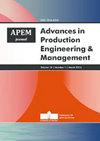Effect of the manufacturer quality inspection policy on the supply chain decision-making and profits
IF 2.8
3区 工程技术
Q2 ENGINEERING, MANUFACTURING
引用次数: 21
Abstract
Due to competitive pressure and information asymmetry, manufacturers will produce quality inspection avoidance behaviour to gain short‐term economic benefits, but this behaviour affects the ultimate quality and safety of the product. This paper studies the two‐echelon supply chain consisting of a manufacturer and a retailer, and analyses whether the manufacturer's quality inspection avoidance behaviour model is considered or not. This paper dis‐ cusses the impact of quality inspection level, quality loss cost, product repair cost, product return rate on the profit and optimal decision‐making behaviour of both actors of the supply chain. It is found that when the manufacturer's quality inspection avoidance level is high, the increase of retailer' quality inspection effort level, manufacturer's internal failure cost, consumer product return rate and retailer' external quality loss cost will lead to the decrease of manufacturer's quality effort level instead of increasing. Finally, the numerical study is given to verify the above conclusion, and analysed the influence of different parameters on the optimal decision and supply chain actors profits. © 2019 CPE, University of Maribor. All rights reserved.制造商质量检验政策对供应链决策和利润的影响
由于竞争压力和信息不对称,制造商为了获得短期经济利益,会产生质量检验回避行为,但这种行为影响了产品的最终质量和安全。本文研究了由制造商和零售商组成的两级供应链,并分析了是否考虑制造商的质量检验回避行为模型。本文讨论了质量检验水平、质量损失成本、产品维修成本、产品退货率对供应链双方利润和最优决策行为的影响。研究发现,当制造商的质量检验规避水平较高时,零售商的质量检验努力水平、制造商的内部失效成本、消费者产品退货率和零售商的外部质量损失成本的增加将导致制造商的质量努力水平降低而不是增加。最后,通过数值研究验证了上述结论,并分析了不同参数对最优决策和供应链参与者利润的影响。©2019马里博尔大学CPE。版权所有。
本文章由计算机程序翻译,如有差异,请以英文原文为准。
求助全文
约1分钟内获得全文
求助全文
来源期刊

Advances in Production Engineering & Management
ENGINEERING, MANUFACTURINGMATERIALS SCIENC-MATERIALS SCIENCE, MULTIDISCIPLINARY
CiteScore
5.90
自引率
22.20%
发文量
19
期刊介绍:
Advances in Production Engineering & Management (APEM journal) is an interdisciplinary international academic journal published quarterly. The main goal of the APEM journal is to present original, high quality, theoretical and application-oriented research developments in all areas of production engineering and production management to a broad audience of academics and practitioners. In order to bridge the gap between theory and practice, applications based on advanced theory and case studies are particularly welcome. For theoretical papers, their originality and research contributions are the main factors in the evaluation process. General approaches, formalisms, algorithms or techniques should be illustrated with significant applications that demonstrate their applicability to real-world problems. Please note the APEM journal is not intended especially for studying problems in the finance, economics, business, and bank sectors even though the methodology in the paper is quality/project management oriented. Therefore, the papers should include a substantial level of engineering issues in the field of manufacturing engineering.
 求助内容:
求助内容: 应助结果提醒方式:
应助结果提醒方式:


